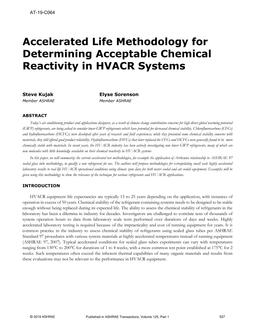Description
Today’s air conditioning product and applications designers, as a result of climate change contribution concerns for high direct global warming potential (GWP) refrigerants, are being asked to consider lower GWP refrigerants which have potential for decreased chemical stability. Chlorofluorocarbons (CFCs) and hydrofluorocarbons (HCFCs) were developed after years of research and field experiences, while they presented some chemical stability concerns with materials, they still offered good product reliability. Hydrofluorocarbons (HFCs) that later replaced the CFCs and HCFCs were generally found to be more chemically stable with materials. In recent years, the HVACR industry has been actively investigating new lower GWP refrigerants, many of which are new molecules with little knowledge available on their chemical reactivity in HVACR systems In this paper, we will summarize the current accelerated test methodologies, for example the application of Arrhenius relationship to ASHRAE 97 sealed glass tube methodology, to qualify a new refrigerant for use. The authors will propose methodologies for extrapolating small scale highly accelerated laboratory results to real life HVACR operational conditions using climate zone data for both water cooled and air cooled equipment. Examples will be given using this methodology to show the relevance of the technique for various refrigerants and HVACR applications.
Citation: 2019 Winter Conference, Atlanta, GA, Conference Papers
Product Details
- Published:
- 2019
- Number of Pages:
- 8
- Units of Measure:
- Dual
- File Size:
- 1 file , 2.9 MB
- Product Code(s):
- D-AT-19-C064




